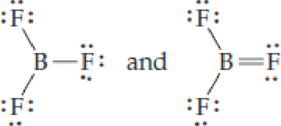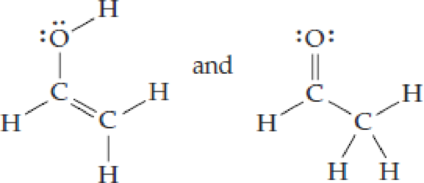
General Chemistry: Atoms First
2nd Edition
ISBN: 9780321809261
Author: John E. McMurry, Robert C. Fay
Publisher: Prentice Hall
expand_more
expand_more
format_list_bulleted
Concept explainers
Textbook Question
Chapter 4, Problem 4.65SP
Which of the following pairs of structures represent resonance forms, and which do not?



Expert Solution & Answer
Want to see the full answer?
Check out a sample textbook solution
Students have asked these similar questions
The quantum yield of the photochemical decay of HI is 2. Calculating the moles of HI per kJ of radiant energy can be decayed knowing that the energy absorbed per mole of photons is 490 kJ.
The quantum yield of the photochemical decay of HI is 2. Calculate the number of Einsteins absorbed per mole knowing that the energy absorbed per mole of photons is 490 kJ.
The quantum yield of the photochemical decay of HI is 2. How many moles of HI per kJ of radiant energy can be decayed knowing that the energy absorbed per mole of photons is 490 kJ.
Chapter 4 Solutions
General Chemistry: Atoms First
Ch. 4.2 - Prob. 4.1PCh. 4.2 - Prob. 4.2PCh. 4.2 - Prob. 4.3CPCh. 4.4 - Use the electronegativity values in Figure 4.4 to...Ch. 4.4 - Order the following compounds according to the...Ch. 4.4 - An electrostatic potential map of water is shown...Ch. 4.5 - Prob. 4.7PCh. 4.5 - Write formulas for compounds with the following...Ch. 4.5 - Prob. 4.9CPCh. 4.6 - Draw electron-dot structures for the following...
Ch. 4.6 - Draw an electron-dot structure for the hydronium...Ch. 4.7 - Draw electron-dot structures for the following...Ch. 4.7 - There are two molecules with the formula C2H6O....Ch. 4.7 - The following structure is a representation of...Ch. 4.8 - Carbon monoxide, CO, is a deadly gas produced by...Ch. 4.8 - Draw an electron-dot structure for each of the...Ch. 4.8 - Prob. 4.17PCh. 4.9 - Prob. 4.18PCh. 4.9 - Draw as many resonance structures as possible for...Ch. 4.9 - The following structure shows the connections...Ch. 4.10 - Calculate the formal charge on each atom in the...Ch. 4.10 - Calculate the formal charge on each atom in the...Ch. 4.10 - What is a radical, and why are they so reactive?Ch. 4.10 - Prob. 4.24PCh. 4.10 - Draw an electron-dot structure for the ethyl...Ch. 4 - Two electrostatic potential maps are shown, one of...Ch. 4 - Prob. 4.27CPCh. 4 - Prob. 4.28CPCh. 4 - Prob. 4.29CPCh. 4 - Sinapaldehyde, a compound present in the toasted...Ch. 4 - Vitamin C (ascorbic acid) has the following...Ch. 4 - What general trends in electronegativity occur in...Ch. 4 - Prob. 4.33SPCh. 4 - Prob. 4.34SPCh. 4 - Prob. 4.35SPCh. 4 - Prob. 4.36SPCh. 4 - Prob. 4.37SPCh. 4 - Prob. 4.38SPCh. 4 - Show the direction of polarity for each of the...Ch. 4 - Prob. 4.40SPCh. 4 - Prob. 4.41SPCh. 4 - Prob. 4.42SPCh. 4 - Prob. 4.43SPCh. 4 - Prob. 4.44SPCh. 4 - Prob. 4.45SPCh. 4 - Prob. 4.46SPCh. 4 - Prob. 4.47SPCh. 4 - Prob. 4.48SPCh. 4 - Prob. 4.49SPCh. 4 - Prob. 4.50SPCh. 4 - Which of the following substances contains an atom...Ch. 4 - Draw electron-dot structures for the following...Ch. 4 - Prob. 4.53SPCh. 4 - Oxalic acid, H2C2O4, is a mildly poisonous...Ch. 4 - Draw an electron-dot structure for carbon...Ch. 4 - Prob. 4.56SPCh. 4 - Prob. 4.57SPCh. 4 - Prob. 4.58SPCh. 4 - Prob. 4.59SPCh. 4 - Methylphenidate (C14H19NO2), marketed as Ritalin,...Ch. 4 - Pregabalin (C8H17NO2), marketed as Lyrica, is an...Ch. 4 - Draw as many resonance structures as you can that...Ch. 4 - Prob. 4.63SPCh. 4 - Which of the following pairs of structures...Ch. 4 - Which of the following pairs of structures...Ch. 4 - Draw an electron-dot structure for carbon...Ch. 4 - Prob. 4.67SPCh. 4 - Prob. 4.68SPCh. 4 - Prob. 4.69SPCh. 4 - Prob. 4.70SPCh. 4 - Prob. 4.71SPCh. 4 - Prob. 4.72SPCh. 4 - Prob. 4.73SPCh. 4 - Prob. 4.74CHPCh. 4 - Thiofulminic acid, , is a highly reactive...Ch. 4 - Draw two resonance structures for methyl...Ch. 4 - Prob. 4.78CHPCh. 4 - Prob. 4.79CHPCh. 4 - Prob. 4.80CHPCh. 4 - Prob. 4.81CHPCh. 4 - Prob. 4.82CHPCh. 4 - Prob. 4.83CHPCh. 4 - Prob. 4.84CHPCh. 4 - Prob. 4.85CHPCh. 4 - Sulfur reacts with chlorine to give a product that...Ch. 4 - Sulfur reacts with ammonia to give a product A...Ch. 4 - Prob. 4.88MPCh. 4 - Prob. 4.89MP
Knowledge Booster
Learn more about
Need a deep-dive on the concept behind this application? Look no further. Learn more about this topic, chemistry and related others by exploring similar questions and additional content below.Similar questions
- If the energy absorbed per mole of photons is 450 kJ, the number of Einsteins absorbed per 1 mole.arrow_forwardWhen propionic aldehyde in vapor form at 200 mmHg and 30°C is irradiated with radiation of wavelength 302 nm, the quantum yield with respect to the formation of CO is 0.54. If the intensity of the incident radiation is 1.5x10-3 W, find the rate of formation of CO.arrow_forwardDraw mechanismarrow_forward
- Does Avogadro's number have units?arrow_forwardExplain why the total E in an Einstein depends on the frequency or wavelength of the light.arrow_forwardIf the dissociation energy of one mole of O2 is 5.17 eV, determine the wavelength that must be used to dissociate it with electromagnetic radiation. Indicate how many Einstein's of this radiation are needed to dissociate 1 liter of O2 at 25°C and 1 atm of pressure.Data: 1 eV = 96485 kJ mol-1; R = 0.082 atm L K-1; c = 2.998x108 m s-1; h = 6.626x10-34 J s; NA = 6.022x 1023 mol-1arrow_forward
- Indicate the number of Einsteins that are equivalent to 550 kJ mol⁻¹ of absorbed energy (wavelength 475 nm).arrow_forwardIndicate the number of einsteins that are equivalent to 550 kJ mol⁻¹ of absorbed energy?arrow_forwardA unit used in photochemistry is the einstein. If 400 kJ mol-1 of energy has been absorbed, how many einsteins is this equivalent to?arrow_forward
- For the condensation reaction between Alanine and histidine write the amididation reaction mechanism using arrows then write the three letter code for the product of the reaction and the one letter code for the product of the reaction.arrow_forwardWrite the amididation reaction mechanism of p-aminophenol and acetic acid to produce acetaminophen please use arrows.arrow_forwardName the following using IUPAC.arrow_forward
arrow_back_ios
SEE MORE QUESTIONS
arrow_forward_ios
Recommended textbooks for you
 Chemistry: The Molecular ScienceChemistryISBN:9781285199047Author:John W. Moore, Conrad L. StanitskiPublisher:Cengage Learning
Chemistry: The Molecular ScienceChemistryISBN:9781285199047Author:John W. Moore, Conrad L. StanitskiPublisher:Cengage Learning Chemistry: Principles and PracticeChemistryISBN:9780534420123Author:Daniel L. Reger, Scott R. Goode, David W. Ball, Edward MercerPublisher:Cengage Learning
Chemistry: Principles and PracticeChemistryISBN:9780534420123Author:Daniel L. Reger, Scott R. Goode, David W. Ball, Edward MercerPublisher:Cengage Learning Chemistry for Engineering StudentsChemistryISBN:9781337398909Author:Lawrence S. Brown, Tom HolmePublisher:Cengage Learning
Chemistry for Engineering StudentsChemistryISBN:9781337398909Author:Lawrence S. Brown, Tom HolmePublisher:Cengage Learning Introductory Chemistry: A FoundationChemistryISBN:9781285199030Author:Steven S. Zumdahl, Donald J. DeCostePublisher:Cengage Learning
Introductory Chemistry: A FoundationChemistryISBN:9781285199030Author:Steven S. Zumdahl, Donald J. DeCostePublisher:Cengage Learning General Chemistry - Standalone book (MindTap Cour...ChemistryISBN:9781305580343Author:Steven D. Gammon, Ebbing, Darrell Ebbing, Steven D., Darrell; Gammon, Darrell Ebbing; Steven D. Gammon, Darrell D.; Gammon, Ebbing; Steven D. Gammon; DarrellPublisher:Cengage Learning
General Chemistry - Standalone book (MindTap Cour...ChemistryISBN:9781305580343Author:Steven D. Gammon, Ebbing, Darrell Ebbing, Steven D., Darrell; Gammon, Darrell Ebbing; Steven D. Gammon, Darrell D.; Gammon, Ebbing; Steven D. Gammon; DarrellPublisher:Cengage Learning Introductory Chemistry: A FoundationChemistryISBN:9781337399425Author:Steven S. Zumdahl, Donald J. DeCostePublisher:Cengage Learning
Introductory Chemistry: A FoundationChemistryISBN:9781337399425Author:Steven S. Zumdahl, Donald J. DeCostePublisher:Cengage Learning

Chemistry: The Molecular Science
Chemistry
ISBN:9781285199047
Author:John W. Moore, Conrad L. Stanitski
Publisher:Cengage Learning

Chemistry: Principles and Practice
Chemistry
ISBN:9780534420123
Author:Daniel L. Reger, Scott R. Goode, David W. Ball, Edward Mercer
Publisher:Cengage Learning

Chemistry for Engineering Students
Chemistry
ISBN:9781337398909
Author:Lawrence S. Brown, Tom Holme
Publisher:Cengage Learning

Introductory Chemistry: A Foundation
Chemistry
ISBN:9781285199030
Author:Steven S. Zumdahl, Donald J. DeCoste
Publisher:Cengage Learning

General Chemistry - Standalone book (MindTap Cour...
Chemistry
ISBN:9781305580343
Author:Steven D. Gammon, Ebbing, Darrell Ebbing, Steven D., Darrell; Gammon, Darrell Ebbing; Steven D. Gammon, Darrell D.; Gammon, Ebbing; Steven D. Gammon; Darrell
Publisher:Cengage Learning

Introductory Chemistry: A Foundation
Chemistry
ISBN:9781337399425
Author:Steven S. Zumdahl, Donald J. DeCoste
Publisher:Cengage Learning
Stoichiometry - Chemistry for Massive Creatures: Crash Course Chemistry #6; Author: Crash Course;https://www.youtube.com/watch?v=UL1jmJaUkaQ;License: Standard YouTube License, CC-BY
Bonding (Ionic, Covalent & Metallic) - GCSE Chemistry; Author: Science Shorts;https://www.youtube.com/watch?v=p9MA6Od-zBA;License: Standard YouTube License, CC-BY
General Chemistry 1A. Lecture 12. Two Theories of Bonding.; Author: UCI Open;https://www.youtube.com/watch?v=dLTlL9Z1bh0;License: CC-BY